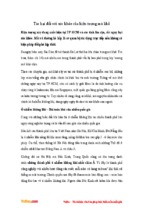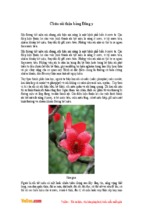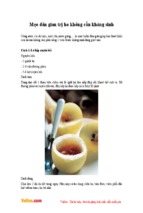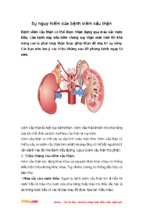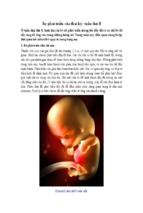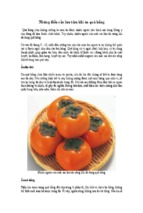Accessed from 128.83.63.20 by nEwp0rt1 on Tue Jun 05 10:49:44 EDT 2012
5186 〈1034〉 Analysis of Biological Assays / General Information
Add the following:
〈1034〉 ANALYSIS OF
BIOLOGICAL ASSAYS
■
1. INTRODUCTION
Although advances in chemical characterization have reduced the reliance on bioassays for many products, bioassays are still essential for the determination of potency and
the assurance of activity of many proteins, vaccines, complex mixtures, and products for cell and gene therapy, as
well as for their role in monitoring the stability of biological
products. The intended scope of general chapter Analysis of
Biological Assays 〈1034〉 includes guidance for the analysis
of results both of bioassays described in the United States
Pharmacopeia (USP), and of non-USP bioassays that seek to
conform to the qualities of bioassay analysis recommended
by USP. Note the emphasis on analysis—design and validation are addressed in complementary chapters (Development
and Design of Bioassays 〈1032〉 and Biological Assay Validation
〈1033〉, respectively).
Topics addressed in 〈1034〉 include statistical concepts and
methods of analysis for the calculation of potency and confidence intervals for a variety of relative potency bioassays,
including those referenced in USP. Chapter 〈1034〉 is intended for use primarily by those who do not have extensive training or experience in statistics and by statisticians
who are not experienced in the analysis of bioassays. Sections that are primarily conceptual require only minimal statistics background. Most of the chapter and all the methods
sections require that the nonstatistician be comfortable with
statistics at least at the level of USP general chapter Analytical Data—Interpretation and Treatment 〈1010〉 and with linear regression. Most of sections 3.4 Nonlinear Models for
Quantitative Response and 3.6 Dichotomous (Quantal) Assays
require more extensive statistics background and thus are
intended primarily for statisticians. In addition, 〈1034〉 introduces selected complex methods, the implementation of
which requires the guidance of an experienced statistician.
Approaches in 〈1034〉 are recommended, recognizing the
possibility that alternative procedures may be employed. Additionally, the information in 〈1034〉 is presented assuming
that computers and suitable software will be used for data
analysis. This view does not relieve the analyst of responsibility for the consequences of choices pertaining to bioassay
design and analysis.
2. OVERVIEW OF ANALYSIS OF BIOASSAY
DATA
Following is a set of steps that will help guide the analysis
of a bioassay. This section presumes that decisions were
made following a similar set of steps during development,
checked during validation, and then not required routinely.
Those steps and decisions are covered in general information chapter Design and Development of Biological Assays
〈1032〉. Section 3 Analysis Models provides details for the
various models considered.
1. As a part of the chosen analysis, select the subset of
data to be used in the determination of the relative
potency using the prespecified scheme. Exclude only
data known to result from technical problems such as
contaminated wells, non-monotonic concentration–response curves, etc.
2. Fit the statistical model for detection of potential outliers, as chosen during development, including any
weighting and transformation. This is done first with-
First Supplement to USP 35–NF 30
out assuming similarity of the Test and Standard
curves but should include important elements of the
design structure, ideally using a model that makes
fewer assumptions about the functional form of the
response than the model used to assess similarity.
3. Determine which potential outliers are to be removed
and fit the model to be used for suitability assessment. Usually, an investigation of outlier cause takes
place before outlier removal. Some assay systems can
make use of a statistical (noninvestigative) outlier removal rule, but removal on this basis should be rare.
One approach to “rare” is to choose the outlier rule
so that the expected number of false positive outlier
identifications is no more than one; e.g., use a 1%
test if the sample size is about 100. If a large number
of outliers are found above that expected from the
rule used, that calls into question the assay.
4. Assess system suitability. System suitability assesses
whether the assay Standard preparation and any controls behaved in a manner consistent with past performance of the assay. If an assay (or a run) fails system suitability, the entire assay (or run) is discarded
and no results are reported other than that the assay
(or run) failed. Assessment of system suitability usually
includes adequacy of the fit of the model used to
assess similarity. For linear models, adequacy of the
model may include assessment of the linearity of the
Standard curve. If the suitability criterion for linearity
of the Standard is not met, the exclusion of one or
more extreme concentrations may result in the criterion being met. Examples of other possible system
suitability criteria include background, positive controls, max/min, max/background, slope, IC50 (or
EC50), and variation around the fitted model.
5. Assess sample suitability for each Test sample. This is
done to confirm that the data for each Test sample
satisfy necessary assumptions. If a Test sample fails
sample suitability, results for that sample are reported
as “Fails Sample Suitability.” Relative potencies for
other Test samples in the assay may still be reported.
Most prominent of sample suitability criteria is similarity, whether parallelism for parallel models or equivalence of intercepts for slope-ratio models. For nonlinear models, similarity assessment involves all curve
parameters other than EC50 (or IC50).
6. For those Test samples in the assay that meet the
criterion for similarity to the Standard (i.e., sufficiently
similar concentration–response curves or similar
straight-line subsets of concentrations), calculate relative potency estimates assuming similarity between
Test and Standard, i.e., by analyzing the Test and
Standard data together using a model constrained to
have exactly parallel lines or curves, or equal
intercepts.
7. A single assay is often not sufficient to achieve a reportable value, and potency results from multiple assays can be combined into a single potency estimate.
Repeat steps 1–6 multiple times, as specified in the
assay protocol or monograph, before determining a
final estimate of potency and a confidence interval.
8. Construct a variance estimate and a measure of uncertainty of the potency estimate (e.g., confidence interval). See section 4 Confidence Intervals.
A step not shown concerns replacement of missing data.
Most modern statistical methodology and software do not
require equal numbers at each combination of concentration and sample. Thus, unless otherwise directed by a specific monograph, analysts generally do not need to replace
missing values.
3. ANALYSIS MODELS
A number of mathematical functions can be successfully
used to describe a concentration–response relationship. The
Official from August 1, 2012
Copyright (c) 2012 The United States Pharmacopeial Convention. All rights reserved.
Accessed from 128.83.63.20 by nEwp0rt1 on Tue Jun 05 10:49:44 EDT 2012
First Supplement to USP 35–NF 30
General Information / 〈1034〉 Analysis of Biological Assays 5187
first consideration in choosing a model is the form of the
assay response. Is it a number, a count, or a category such
as Dead/Alive? The form will identify the possible models
that can be considered.
Other considerations in choosing a model include the
need to incorporate design elements in the model and the
possible benefits of means models compared to regression
models. For purposes of presenting the essentials of the
model choices, section 3 Analysis Models assumes a completely randomized design so that there are no design elements to consider and presents the models in their regression form.
3.1 Quantitative and Qualitative Assay
Responses
The terms quantitative and qualitative refer to the nature
of the response of the assay used in constructing the concentration–response model. Assays with either quantitative
or qualitative responses can be used to quantify product
potency. Note that the responses of the assay at the concentrations measured are not the relative potency of the bioassay. Analysts should understand the differences among responses, concentration–response functions, and relative
potency.
A quantitative response results in a number on a continuous scale. Common examples include spectrophotometric
and luminescence responses, body weights and measurements, and data calculated relative to a standard curve
(e.g., cytokine concentration). Models for quantitative responses can be linear or nonlinear (see sections 3.2–3.5).
A qualitative measurement results in a categorical response. For bioassay, qualitative responses are most often
quantal, meaning they entail two possible categories such as
Positive/Negative, 0/1, or Dead/Alive. Quantal responses
may be reported as proportions (e.g., the proportion of animals in a group displaying a property). Quantal models are
presented in section 3.6. Qualitative responses can have
more than two possible categories, such as end-point titer
assays. Models for more than two categories are not considered in this general chapter.
Assay responses can also be counts, such as number of
plaques or colonies. Count responses are sometimes treated
as quantitative, sometimes as qualitative, and sometimes
models specific to integers are used. The choice is often
based on the range of counts. If the count is mostly 0 and
rarely greater than 1, the assay may be analyzed as quantal
and the response is Any/None. If the counts are large and
cover a wide range, such as 500 to 2500, then the assay
may be analyzed as quantitative, possibly after transformation of the counts. A square root transformation of the
count is often helpful in such analyses to better satisfy homogeneity of variances. If the range of counts includes or is
near 0 but 0 is not the preponderant value, it may be preferable to use a model specific for integer responses. Poisson
regression and negative binomial regression models are
often good options. Models specific to integers will not be
discussed further in this general chapter.
Assays with quantitative responses may be converted to
quantal responses. For example, what may matter is
whether some defined threshold is exceeded. The model
could then be quantal—threshold exceeded or not. In general, assay systems have more precise estimates of potency if
the model uses all the information in the response. Using
above or below a threshold, rather than the measured
quantitative responses, is likely to degrade the performance
of an assay.
3.2 Overview of Models for Quantitative
Responses
In quantitative assays, the measurement is a number on a
continuous scale. Optical density values from plate-based as-
says are such measurements. Models for quantitative assays
can be linear or nonlinear. Although the two display an apparent difference in levels of complexity, parallel-line (linear)
and parallel-curve (nonlinear) models share many commonalities. Because of the different form of the equations, sloperatio assays are considered separately (section 3.5 Slope-Ratio Concentration–Response Models).
Assumptions—The basic parallel-line, parallel-curve, and
slope-ratio models share some assumptions. All include a residual term, e, that represents error (variability) which is assumed to be independent from measurement to measurement and to have constant variance from concentration to
concentration and sample to sample. Often the residual
term is assumed to have a normal distribution as well. The
assumptions of independence and equal variances are commonly violated, so the goal in analysis is to incorporate the
lack of independence and the unequal variances into the
statistical model or the method of estimation.
Lack of independence often arises because of the design
or conduct of the assay. For example, if the assay consists of
responses from multiple plates, observations from the same
plate are likely to share some common influence that is not
shared with observations from other plates. This is an example of intraplate correlation. A simple approach for dealing
with this lack of independence is to include a block term in
the statistical model for plate. With three or more plates this
should be a random effects term so that we obtain an estimate of plate-to-plate variability.
In general, the model needs to closely reflect the design.
The basic model equations given in sections 3.3–3.5 apply
only to completely randomized designs. Any other design
will mean additional terms in the statistical model. For example, if plates or portions of plates are used as blocks, one
will need terms for blocks.
Calculation of Potency—A primary assumption underlying
methods used for the calculation of relative potency is that
of similarity. Two preparations are similar if they contain the
same effective constituent or same effective constituents in
the same proportions. If this condition holds, the Test preparation behaves as a dilution (or concentration) of the Standard preparation. Similarity can be represented mathematically as follows. Let FT be the concentration–response
function for the Test, and let FS be the concentration–response function for the Standard. The underlying
mathematical model for similarity is:
FT(z) = FS(ρ z),
[3.1]
where z represents the concentration and ρ represents the
relative potency of the Test sample relative to the Standard
sample.
Methods for estimating ρ in some common concentration–response models are discussed below. For linear models, the distinction between parallel-line models (section 3.3
Parallel-Line Models for Quantitative Response) and slope-ratio
models (section 3.5 Slope-Ratio Concentration–Response Models) is based on whether a straight-line fit to log concentration or concentration yields better agreement between the
model and the data over the range of concentrations of
interest.
3.3 Parallel-Line Models for Quantitative
Responses
In this section, a linear model refers to a concentration–response relationship, which is a straight-line (linear)
function between the logarithm of concentration, x, and the
response, y. y may be the response in the scale as measured
or a transformation of the response. The functional form of
this relationship is y = a + bx. Straight-line fits may be used
for portions of nonlinear concentration–response curves, although doing so requires a method for selecting the con-
Official from August 1, 2012
Copyright (c) 2012 The United States Pharmacopeial Convention. All rights reserved.
Accessed from 128.83.63.20 by nEwp0rt1 on Tue Jun 05 10:49:44 EDT 2012
5188 〈1034〉 Analysis of Biological Assays / General Information
First Supplement to USP 35–NF 30
centrations to use for each of the Standard and Test samples
(see 〈1032〉).
Means Model versus Regression—A linear concentration–response model is most often analyzed with least
squares regression. Such an analysis results in estimates of
the unknown coefficients (intercepts and slope) and their
standard errors, as well as measures of the goodness of fit
[e.g., R2 and root-mean-square error (RMSE)].
Linear regression works best where all concentrations can
be used and there is negligible curvature in the concentration–response data. Another statistical method for analyzing
linear concentration–response curves is the means model.
This is an analysis of variance (ANOVA) method that offers
some advantages, particularly when one or more concentrations from one or more samples are not used to estimate
potency. Because a means model includes a separate mean
for each unique combination of sample and dose (as well as
block or other effects associated with the design structure) it
is equivalent to a saturated polynomial regression model.
Hence, a means model provides an estimate of error that is
independent of regression lack of fit. In contrast, a regression residual based estimate of error is a mixture of the assay error, as estimated by the means model, combined with
lack of fit of the regression model. At least in this sense, the
means model error is a better estimate of the residual error
variation in an assay system.
Parallel-Line Concentration–Response Models—If the general concentration–response model (3.1 Quantitative and
Qualitative Assay Responses) can be made linear in x =
log(z), the resulting equation is then:
assumption holds, the parameters of equation [3.2] are chosen to minimize
y = α + βlog(z) + e = α + βx + e,
Commonly available statistical software and spreadsheets
provide routines for least squares. Not all software can provide weighted analyses.
See section 4 for methods to obtain a confidence interval
for the estimated relative potency. For a confidence interval
based on combining relative potency estimates from multiple assays, use the methods of section 4.2. For a confidence
interval from a single assay, use Fieller’s Theorem (section
where e is the residual or error term, and the intercept, α,
and slope, β, will differ between Test and Standard. With
the parallelism (equal slopes) assumption, the model
becomes
yS = α + βlog(z) + e = αS + βx + e
[3.2]
yT = α + βlog(ρz) + e = [α + βlog(ρ)] + βx + e = αT + βx + e,
where S denotes Standard, T denotes Test, αS = α is the yintercept for the Standard, and αT = α + βlog(ρ) is the yintercept for the Test (see Figure 3.1).
where the carets denote estimates. This is a linear regression
with two independent variables, T and x, where T is a variable that equals 1 for observations from the Test and 0 for
observations from the Standard. The summation in equation
[3.3] is over all observations of the Test and Standard. If the
equal variance assumption does not hold but the variance is
known to be inversely proportional to a value, w, that does
not depend on the current responses, the y’s, and can be
determined for each observation, then the method is
weighted least squares
Equation 3.4 is appropriate only if the weights are determined without using the response, the y’s, from the current
data (see 〈1032〉 for guidance in determining weights). In
equations [3.3] and [3.4] β is the same as the β in equation
[3.2] and δ = αT − αS = βlog ρ. So, the estimate of the
relative potency, ρ, is
4.3) applied to
.
Measurement of Nonparallelism—Parallelism for linear
models is assessed by considering the difference or ratio of
the two slopes. For the difference, this can be done by fitting the regression model,
y = αS + δT + βSx + γxT + e
where δ = αT − αS, γ = βT − βS, and T = 1 for Test data and T
= 0 for Standard data. Then use the standard t-distribution
confidence interval for γ. For the ratio of slopes, fit
y = αS + δT + βSx(1 − T) + βTxT + e
and use Fieller’s Theorem, equation [4.3], to obtain a confidence interval for βT/βS.
Figure 3.1. Example of parallel-line model.
3.4 Nonlinear Models for Quantitative
Responses
Where concentration–response lines are parallel, as shown
in Figure 3.1, a separation or horizontal shift indicates a difference in the level of biological activity being assayed. This
horizontal difference is numerically log(ρ), the logarithm of
the relative potency, and is found as the vertical distance
between the lines αT and αS divided by the slope, β. The
relative potency is then
Nonlinear concentration–response models are typically Sshaped functions. They occur when the range of concentrations is wide enough so that responses are constrained by
upper and lower asymptotes. The most common of these
models is the four-parameter logistic function as given
below.
Let y denote the observed response and z the concentration. One form of the four-parameter logistic model is
Estimation of Parallel-line Models—Parallel-line models are
fit by the method of least squares. If the equal variance
Official from August 1, 2012
Copyright (c) 2012 The United States Pharmacopeial Convention. All rights reserved.
Accessed from 128.83.63.20 by nEwp0rt1 on Tue Jun 05 10:49:44 EDT 2012
First Supplement to USP 35–NF 30
General Information / 〈1034〉 Analysis of Biological Assays 5189
One alternative, but equivalent, form is
The two forms correspond as follows:
Lower asymptote: D = a0
Upper asymptote: A = a0 + d
Steepness: B = M (related to the slope of the curve at
the EC50)
Effective concentration 50% (EC50): C = antilog(b) (may
also be termed ED50).
Any convenient base for logarithms is suitable; it is often
convenient to work in log base 2, particularly when concentrations are twofold apart.
The four-parameter logistic curve is symmetric around the
EC50 when plotted against log concentration because the
rates of approach to the upper and lower asymptotes are
the same (see Figure 3.2). For assays where this symmetry
does not hold, asymmetrical model functions may be applied. These models are not considered further in this general chapter.
Figure 3.3. Example of parallel curves from a nonlinear
model.
The equations corresponding to the figure (with error
term, e, added) are
or
Figure 3.2. Examples of symmetric (four-parameter logistic)
and asymmetric sigmoids.
In many assays the analyst has a number of strategic
choices to make during assay development (see Development and Design of Biological Assays 〈1032〉). For example,
the responses could be modeled using a transformed response to a four-parameter logistic curve, or the responses
could be weighted and fit to an asymmetric sigmoid curve.
Also, it is often important to include terms in the model
(often random effects) to address variation in the responses
(or parameters of the response) associated with blocks or
experimental units in the design of the assay. For simple
assays where observations are independent, these strategic
choices are fairly straightforward. For assays performed with
grouped dilutions (as with multichannel pipets), assays with
serial dilutions, or assay designs that include blocks (as with
multiple plates per assay), it is usually a serious violation of
the statistical assumptions to ignore the design structure.
For such assays, a good approach involves a transformation
that approximates a solution to non-constant variance, nonnormality, and asymmetry combined with a model that captures the important parts of the design structure.
Parallel-Curve Concentration–Response Models—The concept of parallelism is not restricted to linear models. For
nonlinear curves, parallel or similar means the concentration–response curves can be superimposed following a horizontal displacement of one of the curves, as shown in Figure
3.3 for four-parameter logistic curves. In terms of the parameters of equation [3.5], this means the values of A, D,
and B for the Test are the same as for the Standard.
Log ρ is the log of the relative potency and the horizontal
distance between the two curves, just as for the parallel-line
model. Because the EC50 of the standard is antilog(b) and
that of the Test is antilog(b − log ρ) = antilog(b)/ρ, the
relative potency is the ratio of EC50’s (standard over Test)
when the parallel-curve model holds.
Estimation of Parallel-Curve Models—Estimation of nonlinear, parallel-curve models is similar to that for parallel-line
models, possibly after transformation of the response and
possibly with weighting. For the four-parameter logistic
model, the parameter estimates are found by minimizing:
without weighting, or
with weighting. (As for equation [3.4], equation [3.6] is appropriate only if the weights are determined without using
the responses, y’s, from the current data.) In either case, the
estimate of r is the estimate of the log of the relative potency. For some software, it may be easier to work with
d = A − D.
The parameters of the four-parameter logistic function
and those of the asymmetric sigmoid models cannot be
found with ordinary (linear) least squares regression routines. Computer programs with nonlinear estimation techniques must be used.
Analysts should not use the nonlinear regression fit to assess parallelism or estimate potency if any of the following
are present: a) inadequate asymptote information is available; or b) a comparison of pooled error(s) from nonlinear
regression to pooled error(s) from a means model shows
that the nonlinear model does not fit well; or c) other ap-
Official from August 1, 2012
Copyright (c) 2012 The United States Pharmacopeial Convention. All rights reserved.
Accessed from 128.83.63.20 by nEwp0rt1 on Tue Jun 05 10:49:44 EDT 2012
5190 〈1034〉 Analysis of Biological Assays / General Information
propriate measures of goodness of fit show that the nonlinear model is not appropriate (e.g., residual plots show
evidence of a “hook”).
See section 4 for methods to obtain a confidence interval
for the estimated relative potency. For a confidence interval
based on combining relative potency estimates from multiple assays, use the methods of section 4.2. For a confidence
interval from a single assay, advanced techniques, such as
likelihood profiles or bootstrapping are needed to obtain a
confidence interval for the log relative potency, r.
Measurement of Nonparallelism—Assessment of parallelism
for a four-parameter logistic model means assessing the
slope parameter and the two asymptotes. During development (see 〈1032〉), a decision should be made regarding
which parameters are important and how to measure
nonparallelism. As discussed in 〈1032〉, the measure of nonsimilarity may be a composite measure that considers all
parameters together in a single measure, such as the parallelism sum of squares (see 〈1032〉), or may consider each
parameter separately. In the latter case, the measure may be
functions of the parameters, such as an asymptote divided
by the difference of asymptotes or the ratio of the asymptotes. For each parameter (or function of parameters), confidence intervals can be computed by bootstrap or likelihood
profile methods. These methods are not presented in this
general chapter.
3.5 Slope-Ratio Concentration–Response
Models
First Supplement to USP 35–NF 30
results as in equation [3.7]. The relative potency is then
found from the ratio of the slopes:
Relative Potency =
Test sample slope/Standard sample slope =
βρ/β = ρ
Assumptions for and Estimation of Slope-Ratio Models—The
assumptions for the slope-ratio model are the same as for
parallel-line models: The residual terms are independent,
have constant variance, and may need to have a normal
distribution. The method of estimation is also least squares.
This may be implemented either with or without weighting,
as demonstrated in equations [3.8] and [3.9], respectively.
Equation [3.9] is appropriate only if the weights are determined without using the response, the y’s, from the current
data. This is a linear regression with two independent variables, z(1 − T) and zT, where T = 1 for Test data and T = 0
for Standard data.
is the estimated slope for the Test,
the estimated slope for the Standard, and then the estimate
of relative potency is
If a straight-line regression fits the nontransformed concentration–response data well, a slope-ratio model may be
used. The equations for the slope-ratio model assuming similarity are then:
yS = α + βz + e = α + βSz + e
[3.7]
yT = α + β(ρz) + e = α + βSρz + e = α + βTz + e
An identifying characteristic of a slope-ratio concentration–response model that can be seen in the results of a
ranging study is that the lines for different potencies from a
ranging study have the same intercept and different slopes.
Thus, a graph of the ranging study resembles a fan. Figure
3.4 shows an example of a slope-ratio concentration–response model. Note that the common intercept need
not be at the origin.
Figure 3.4. Example of slope-ratio model.
An assay with a slope-ratio concentration–response model
for measuring relative potency consists, at a minimum, of
one Standard sample and one Test sample, each measured
at one or more concentrations and, usually, a measured response with no sample (zero concentration). Because the
concentrations are not log transformed, they are typically
equally spaced on the original, rather than log, scale. The
model consists of one common intercept, a slope for the
Test sample results, and a slope for the Standard sample
Because the slope-ratio model is a linear regression model,
most statistical packages and spreadsheets can be used to
obtain the relative potency estimate. In some assay systems,
it is sometimes appropriate to omit the zero concentration
(e.g., if the no-dose controls are handled differently in the
assay) and at times one or more of the high concentrations
(e.g., if there is a hook effect where the highest concentrations do not have the highest responses). The discussion
about using a means model and selecting subsets of concentrations for straight parallel-line bioassays applies to
slope-ratio assays as well.
See section 4 for methods to obtain a confidence interval
for the estimated relative potency. For a confidence interval
based on combining relative potency estimates from multiple assays, use the methods of section 4.2. For a confidence
interval from a single assay, use Fieller’s Theorem (section
4.3) applied to
Measurement of Nonsimilarity—For slope-ratio models,
statistical similarity corresponds to equal intercepts for the
Standard and Test. To assess the similarity assumption it is
necessary to have at least two nonzero concentrations for
each sample. If the intercepts are not equal, equation [3.7]
becomes
yS = αS + βSz + e
yT = αT + βTz + e
Departure from similarity is typically measured by the difference of intercepts, αT − αS. An easy way to obtain a confidence interval is to fit the model,
y = αS + δT + βSz(1 − T) + βTzT + e,
where δ = αT − αS and use the standard t-distribution-based
confidence interval for δ.
Official from August 1, 2012
Copyright (c) 2012 The United States Pharmacopeial Convention. All rights reserved.
Accessed from 128.83.63.20 by nEwp0rt1 on Tue Jun 05 10:49:44 EDT 2012
First Supplement to USP 35–NF 30
General Information / 〈1034〉 Analysis of Biological Assays 5191
3.6 Dichotomous (Quantal) Assays
For quantal assays the assay measurement has a dichotomous or binary outcome, e.g., in animal assays the animal is
dead or alive or a certain physiologic response is or is not
observed. For cellular assays, the quantal response may be
whether there is or is not a response beyond some threshold in the cell. In cell-based viral titer or colony-forming
assays, the quantal response may be a limit of integer response such as an integer number of particles or colonies.
When one can readily determine if any particles are present—but not their actual number—then the assay can be
analyzed as quantal. Note that if the reaction can be quantitated on a continuous scale, as with an optical density, then
the assay is not quantal.
Models for Quantal Analyses—The key to models for
quantal responses is to work with the probability of a response (e.g., probability of death), in contrast to quantitative responses for which the model is for the response itself.
For each concentration, z, a treated animal, as an example,
has a probability of responding to that concentration, P(z).
Often the curve P(z) can be approximated by a sigmoid
when plotted against the logarithm of concentration, as
shown in Figure 3.5. This curve shows that the probability of
responding increases with concentration. The concentration
that corresponds to a probability of 0.5 is the EC50.
els in section 3.3 Parallel-Line Models for Quantitative responses apply to quantal models as well.
For a logit analysis with Standard and Test preparations,
let T be a variable that takes the value 1 for animals receiving the Test preparation and 0 for animals receiving the
Standard. Assuming parallelism of the Test and Standard
curves, the logit model for estimating relative potency is
then:
The log of the relative potency of the Test compared to
the Standard preparation is then β2/β1. The two curves in
Figure 3.6 show parallel Standard and Test sigmoids. (If the
corresponding linear forms equation [3.10] were shown,
they would be two parallel straight lines.) The log of the
relative potency is the horizontal distance between the two
curves, in the same way as for the linear and four-parameter
logistic models given for quantitative responses (sections 3.3
Parallel-Line Models for Quantitative Responses and 3.4 Nonlinear Models for Quantitative Responses).
Figure 3.6. Example of Parallel Sigmoid Curves.
Figure 3.5. Example of sigmoid for P(z).
The sigmoid curve is usually modeled based on the normal or logistic distribution. If the normal distribution is used,
the resulting analysis is termed probit analysis, and if the
logistic is used the analysis is termed logit or logistic analysis. The probit and logit models are practically indistinguishable, and either is an acceptable choice. The choice may be
based on the availability of software that meets the
laboratory’s analysis and reporting needs. Because software
is more commonly available for logistic models (often under
the term logistic regression) this discussion will focus on the
use and interpretation of logit analysis. The considerations
discussed in this section for logit analysis (using a logit
transformation) apply as well to probit analysis (using a
probit transformation).
Logit Model—The logit model for the probability of response, P(z), can be expressed in two equivalent forms. For
the sigmoid,
Estimating the Model Parameters and Relative Potency—
Two methods are available for estimating the parameters of
logit and probit models: maximum likelihood and weighted
least squares. The difference is not practically important,
and the laboratory can accept the choice made by its
software. The following assumes a general logistic regression
software program. Specialized software should be similar.
Considering the form of equation [3.10], one observes a
resemblance to linear regression. There are two independent
variables, x = log(z) and T. For each animal, there is a yes/
no dependent variable, often coded as 1 for yes or response
and 0 for no or no response. Although bioassays are often
designed with equal numbers of animals per concentration,
that is not a requirement of analysis. Utilizing the parameters estimated by software, which include β0, β1, and β2 and
their standard errors, one obtains the estimate of the natural
log of the relative potency:
See section 4 for methods to obtain a confidence interval
for the estimated relative potency. For a confidence interval
based on combining relative potency estimates from multiple assays, use the methods of section 4.2. For a confidence
interval from a single assay, use Fieller’s Theorem (section
where log(ED50) = − β0/β1. An alternative form shows the
relationship to linear models:
The linear form is usually shown using natural logs and is
a useful reminder that many of the considerations, in particular linearity and parallelism, discussed for parallel-line mod-
4.3) applied to
. The confidence interval for the relative potency is then [antilog(L), antilog(U)], where [L, U] is
the confidence interval for the log relative potency.
Assumptions—Assumptions for quantal models have two
parts. The first concerns underlying assumptions related to
the probability of response of each animal or unit in the
bioassay. These are difficult to verify assumptions that depend on the design of the assay. The second part concerns
assumptions for the statistical model for P(z). Most important of these are parallelism and linearity. These assumptions
Official from August 1, 2012
Copyright (c) 2012 The United States Pharmacopeial Convention. All rights reserved.
Accessed from 128.83.63.20 by nEwp0rt1 on Tue Jun 05 10:49:44 EDT 2012
5192 〈1034〉 Analysis of Biological Assays / General Information
can be checked much as for parallel-line analyses for quantitative responses.
In most cases, quantal analyses assume a standard binomial probability model, a common choice of distribution for
dichotomous data. The key assumptions of the binomial are
that at a given concentration each animal treated at that
concentration has the same probability of responding and
the results for any animal are independent from those of all
other animals. This basic set of assumptions can be violated
in many ways. Foremost among them is the presence of
litter effects, where animals from the same litter tend to
respond more alike than do animals from different litters.
Cage effects, in which the environmental conditions or care
rendered to any specific cage makes the animals from that
cage more or less likely to respond to experimental treatment, violates the equal-probability and independence assumptions. These assumption violations and others like them
(that could be a deliberate design choice) do not preclude
the use of logit or probit models. Still, they are indications
that a more complex approach to analysis than that
presented here may be required (see 〈1032〉).
Checking Assumptions—The statistical model for P(z) assumes linearity and parallelism. To assess parallelism, equation [3.10] may be modified as follows:
Here, β3 is the difference of slopes between Test and Standard and should be sufficiently small. [The T*log(z) term is
known as an interaction term in statistical terminology.] The
measure of nonparallelism may also be expressed in terms
of the ratio of slopes, (β1 + β3)/β1. For model-based confidence intervals for these measures of nonparallelism, bootstrap or profile likelihood methods are recommended. These
methods are not covered in this general chapter.
To assess linearity, it is good practice to start with a
graphical examination. In accordance with equation [3.10],
this would be a plot of log[(y + 0.5)/(n − y + 0.5)] against
log(concentration), where y is the total number of responses
at the concentration and n is the number of animals at that
concentration. (The 0.5 corrections improve the properties
of this calculation as an estimate of log[P/(1 − P)].) The lines
for Test and Standard should be parallel straight lines as for
the linear model in quantitative assays. If the relationship is
monotonic but does not appear to be linear, then the
model in [3.10] can be extended with other terms. For example, a quadratic term in log(concentration) could be
added: [log(concentration)]2. If concentration needs to be
transformed to something other than log concentration,
then the quantal model analogue of slope-ratio assays is an
option. The latter is possible but sufficiently unusual that it
will not be discussed further in this general chapter.
Outliers—Assessment of outliers is more difficult for quantal assays than for quantitative assays. Because the assay response can be only yes or no, no individual response can be
unusual. What may appear to fall into the outlier category is
a single response at a low concentration or a single noresponse at a high concentration. Assuming that there has
been no cause found (e.g., failure to properly administer the
drug to the animal), there is no statistical basis for distinguishing an outlier from a rare event.
Alternative Methods—Alternatives to the simple quantal
analyses outlined here may be acceptable, depending on
the nature of the analytical challenge. One such challenge is
a lack of independence among experimental units, as may
be seen in litter effects in animal assays. Some of the possible approaches that may be employed are Generalized Estimating Equations (GEE), generalized linear models, and generalized linear mixed-effects models. A GEE analysis will yield
standard errors and confidence intervals whose validity does
not depend on the satisfaction of the independence
assumption.
First Supplement to USP 35–NF 30
There are also methods that make no particular choice of
the model equation for the sigmoid. A commonly seen example is the Spearman–Kärber method.
4. CONFIDENCE INTERVALS
A report of an assay result should include a measure of
the uncertainty of that result. This is often a standard error
or a confidence interval. An interval (c, d), where c is the
lower confidence limit and d is the upper confidence limit,
is a 95% confidence interval for a parameter (e.g., relative
potency) if 95% of such intervals upon repetition of the
experiment would include the actual value of the parameter.
A confidence interval may be interpreted as indicating values of the parameter that are consistent with the data. This
interpretation of a confidence interval requires that various
assumptions be satisfied. Assumptions also need to be satisfied when the width or half width [(d-c)/2] are used in a
monograph as a measure of whether there is adequate precision to report a potency. The interval width is sometimes
used as a suitability criterion without the confidence interpretation. In such cases the assumptions need not be
satisfied.
Confidence intervals can either be model-based or samplebased. A model-based interval is based on the standard errors for each of the one or more estimates of log relative
potency that come from the analysis of a particular statistical model. Model-based intervals should be avoided if sample-based intervals are possible. Model-based intervals require that the statistical model correctly incorporate all the
effects and correlations that influence the model’s estimate
of precision. These include but are not be limited to serial
dilution and plate effects. Section 4.3 Model-Based Methods
describes Fieller’s Theorem, a commonly used model-based
interval.
Sample-based methods combine independent estimates of
log relative potency. Multiple assays may arise because this
was determined to be required during development and validation or because the assay procedure fixes a maximum
acceptable width of the confidence interval and two or
more independent assays may be needed to meet the specified width requirement. Some sample-based methods do
not require that the statistical model correctly incorporate all
effects and correlations. However, this should not be interpreted as dismissing the value of addressing correlations and
other factors that influence within-assay precision. The
within-assay precision is used in similarity assessment and is
a portion of the variability that is the basis for the samplebased intervals. Thus minimizing within-assay variability to
the extent practical is important. Sample-based intervals are
covered in section 4.2 Combining Independent Assays (Sample-Based Confidence Interval Methods).
4.1 Combining Results from Multiple Assays
In order to mitigate the effects of variability, it is appropriate to replicate independent bioassays and combine their
results to obtain a single reportable value. That single reportable value (and not the individual assay results) is then
compared to any applicable acceptance criteria. During assay development and validation, analysts should evaluate
whether it is useful to combine the results of such assays
and, if so, in what way to proceed.
There are two primary questions to address when considering how to combine results from multiple assays:
Are the assays mutually independent?
A set of assays may be regarded as mutually independent when the responses of one do not in any way
depend on the distribution of responses of any of the
others. This implies that the random errors in all essential factors influencing the result (for example, dilutions of the standard and of the preparation to be
examined or the sensitivity of the biological indicator)
Official from August 1, 2012
Copyright (c) 2012 The United States Pharmacopeial Convention. All rights reserved.
Accessed from 128.83.63.20 by nEwp0rt1 on Tue Jun 05 10:49:44 EDT 2012
First Supplement to USP 35–NF 30
General Information / 〈1034〉 Analysis of Biological Assays 5193
in one assay must be independent of the corresponding random errors in the other assays. Assays on successive days using the original and retained dilutions
of the Standard, therefore, are not independent assays. Similarly, if the responses, particularly the potency, depend on other reagents that are shared by
assays (e.g., cell preparations), the assays may not be
independent.
Assays need not be independent in order for analysts
to combine results. However, methods for independent assays are much simpler. Also, combining dependent assay results may require assumptions about
the form of the correlation between assay results that
may be, at best, difficult to verify. Statistical methods
are available for dependent assays, but they are not
presented in this general chapter.
Are the results of the assays homogeneous?
Homogeneous results differ only because of random
within-assay errors. Any contribution from factors associated with intermediate precision precludes homogeneity of results. Intermediate precision factors are
those that vary between assays within a laboratory
and can include analyst, equipment, and environmental conditions. There are statistical tests for heterogeneity, but lack of statistically significant heterogeneity
is not properly taken as assurance of homogeneity
and so no test is recommended. If analysts use a
method that assumes homogeneity, homogeneity
should be assessed during development, documented
during validation, and monitored during ongoing use
of the assay.
Additionally, before results from assays can be combined,
analysts should consider the scale on which that combination is to be made. In general, the combination should be
done on the scale for which the parameter estimates are
approximately normally distributed. Thus, for relative
potencies based on a parallel-line, parallel-curve, or quantal
method, the relative potencies are combined in the logarithm scale.
4.2 Combining Independent Assays (SampleBased Confidence Interval Methods)
Analysts can use several methods for combining the results of independent assays. A simple method described below (Method 1) assumes a common distribution of relative
potencies across the assays and is recommended. A second
procedure is provided and may be useful if homogeneity of
relative potency across assays can be documented. A third
alternative is useful if the assumptions for Methods 1 and 2
are not satisfied. Another alternative, analyzing all assays together using a linear or nonlinear mixed-effects model, is
not discussed in this general chapter.
Method 1—Independent Assay Results From a Common
Assay Distribution—The following is a simple method that
assumes independence of assays. It is assumed that the individual assay results (logarithms of relative potencies) are
from a common normal distribution with some nonzero variance. This common distribution assumption requires that
all assays to be combined used the same design and laboratory procedures. Implicit is that the relative potencies may
differ between the assays. This method thus captures interassay variability in relative potency. Note that the individual
relative potencies should not be rounded before combining
results.
Let Ri denote the logarithm of the relative potency of the
ith assay of N assay results to be combined. To combine the
N results, the mean, standard deviation, and standard error
of the Ri are calculated in the usual way:
A 100(1 − α)% confidence interval is then found as
R ± tN −1,α/2SE,
where tN − 1,α/2 is the upper α/2 percentage point of a tdistribution with N − 1 degrees of freedom. The quantity
tN − 1,α/2SE is the expanded uncertainty of R. The number,
N, of assays to be combined is usually small, and hence the
value of t is usually large.
Because the results are combined in the logarithm scale,
the combined result can be reported in the untransformed
scale as a confidence interval for the geometric mean potency, estimated by antilog(R),
Method 2—Independent Assay Results, Homogeneity
Assumed—This method can be used provided the following
conditions are fulfilled:
(1) The individual potency estimates form a homogeneous set with regard to the potency being estimated.
Note that this means documenting (usually during development and validation) that there are no contributions to between-assay variability from intermediate
precision factors. The individual results should appear
to be consistent with homogeneity. In particular, differences between them should be consistent with
their standard errors.
(2) The potency estimates are derived from independent
assays.
(3) The number of degrees of freedom of the individual
residual errors is not small. This is required so that
the weights are well determined.
When these conditions are not fulfilled, this method cannot be applied and Method 1, Method 3, or some other
method should be used. Further note that Method 2 (because it assumes no inter-assay variability) often results in
narrower confidence intervals than Method 1, but this is not
sufficient justification for using Method 2 absent satisfaction
of the conditions listed above.
Calculation of Weighting Coefficients—It is assumed that
the results of each of the N assays have been analyzed to
give N estimates of log potency with associated confidence
limits. For each assay, i, the logarithmic confidence interval
for the log potency or log relative potency and a value Li
are obtained by subtracting the lower confidence limit from
the upper. (This formula, using the Li, accommodates asymmetric confidence intervals such as from Fieller’s Theorem,
section 4.3 Model-Based Methods). A weight Wi for each
value of the log relative potency, Ri, is calculated as follows,
where ti has the same value as that used in the calculation
of confidence limits in the ith assay:
Calculation of the Weighted Mean and Confidence Limits—
The products WiRi are formed for each assay, and their sum
is divided by the total weight for all assays to give the
Official from August 1, 2012
Copyright (c) 2012 The United States Pharmacopeial Convention. All rights reserved.
Accessed from 128.83.63.20 by nEwp0rt1 on Tue Jun 05 10:49:44 EDT 2012
5194 〈1034〉 Analysis of Biological Assays / General Information
First Supplement to USP 35–NF 30
weighted mean log relative potency and its standard error
as follows:
the estimates of a and b.) The covariance may be 0, as for
some parameterizations of standard parallel-line analyses,
but it need not be. The confidence interval for R then is as
follows:
A 100(1 − α)% confidence interval in the log scale is then
found as
where
R ± tk,α/2SE
[4.2]
where tk,α/2 is the upper α/2 percentage point of a t-distribution with degrees of freedom, k, equal to the sum of the
number of degrees of freedom for the error mean squares in
the individual assays. This confidence interval can then be
transformed back to the original scale as for Method 1.
Method 3—Independent Assay Results, Common Assay
Distribution Not Assumed—Method 3 is an approximate
method that may be considered if the conditions for
Method 1 (common assay distribution) or Method 2 (homogeneity) are not met.
The observed variation then has two components:
• the intra-assay variation for assay i:
• the inter-assay variation:
as
For each assay, a weighting coefficient is then calculated
which replaces Wi in equation [4.1] and where t in equation
[4.2] is often approximated by the value 2.
4.3 Model-Based Methods
Many confidence intervals are of the form:
Confidence interval = value ± k times the standard error of
that value.
For such cases, as long as the multiplier k can be easily
determined (e.g., from a table of the t-distribution), reporting the standard error and the confidence interval are
largely equivalent because the confidence interval is then
easily determined from the standard error. However, the
logarithms of relative potencies for parallel-line models and
some parameterizations of nonlinear models and the relative
potencies from slope-ratio models are ratios. In such cases,
the confidence intervals are not symmetric around the estimated log relative potency or potency, and Fieller’s Theorem is needed. For these asymmetric cases the confidence
interval should be reported because the standard error by
itself does not capture the asymmetry.
Fieller’s Theorem is the formula for the confidence interval
for a ratio. Let R = a/b be the ratio for which we need a
confidence interval. For the estimates of a and b, we have
their respective standard errors, SEa and SEb, and a covariance between them, denoted Cov. (The covariance is a
measure of the degree to which the estimates of a and b
are related and is proportional to the correlation between
and t is the appropriate t deviate value that will depend on
the sample size and confidence level chosen (usually 95%).
If g > 1, it means that the denominator, , is not statistically significantly different from 0 and the use of the ratio is
not sensible for those data.
For those cases where the estimates of a and b are statistically uncorrelated (Cov = 0), the confidence interval formula
simplifies to
5. ADDITIONAL SOURCES OF INFORMATION
A variety of statistical methods can be used to analyze
bioassay data. This chapter presents several methods, but
many other similar methods could also be employed. Additional information and alternative procedures can be found
in the references listed below and other sources.
1. Bliss CI. The Statistics of Bioassay. New York: Academic Press; 1952.
2. Bliss CI. Analysis of the biological assays in U.S.P. XV. Drug Stand.
1956;24:33–67.
3. Böhrer A. One-sided and two-sided critical values for Dixon’s outlier
test for sample sizes up to n = 30. Econ Quality Control. 2008;23:5–13.
4. Brown F, Mire-Sluis A, eds. The Design and Analysis of Potency
Assays for Biotechnology Products. New York: Karger; 2002.
5. Callahan JD, Sajjadi NC. Testing the null hypothesis for a specified
difference—the right way to test for parallelism. Bioprocessing J.
2003:2;71–78.
6. DeLean A, Munson PJ, Rodbard D. Simultaneous analysis of families
of sigmoidal curves: application to bioassay, radioligand assay, and
physiological dose–response curves. Am J Physiol. 1978;235:E97–E102.
7. European Directorate for the Quality of Medicines. European Pharmacopoeia, Chapter 5.3, Statistical Analysis. Strasburg, France: EDQM;
2004:473–507.
8. Finney DJ. Probit Analysis. 3rd ed. Cambridge: Cambridge University
Press; 1971.
9. Finney DJ. Statistical Method in Biological Assay. 3rd ed. London:
Griffin; 1978.
10. Govindarajulu Z. Statistical Techniques in Bioassay. 2nd ed. New York:
Karger; 2001.
11. Hauck WW, Capen RC, Callahan JD, et al. Assessing parallelism prior
to determining relative potency. PDA J Pharm Sci Technol.
2005;59:127–137.
12. Hewitt W. Microbiological Assay for Pharmaceutical Analysis: A Rational
Approach. New York: Interpharm/CRC; 2004.
13. Higgins KM, Davidian M, Chew G, Burge H. The effect of serial
dilution error on calibration inference in immunoassay. Biometrics.
1998;54:19–32.
14. Hurlbert, SH. Pseudo replication and the design of ecological field
experiments. Ecological Monogr. 1984;54:187–211.
Official from August 1, 2012
Copyright (c) 2012 The United States Pharmacopeial Convention. All rights reserved.
Accessed from 128.83.63.20 by nEwp0rt1 on Tue Jun 05 10:49:44 EDT 2012
First Supplement to USP 35–NF 30
General Information / 〈1034〉 Analysis of Biological Assays 5195
15. Iglewicz B, Hoaglin DC. How to Detect and Handle Outliers. Milwaukee, WI: Quality Press; 1993.
16. Nelder JA, Wedderburn RWM. Generalized linear models. J Royal
Statistical Soc, Series A. 1972;135:370–384.
17. Rorabacher DB. Statistical treatment for rejection of deviant values:
critical values of Dixon’s “Q” parameter and related subrange ratios at
the 95% confidence level. Anal Chem. 1991;63:39–48.
APPENDIX–GLOSSARY
[NOTE—This glossary is applicable to 〈111〉, 〈1032〉,
〈1033〉, and 〈1034〉.]
GLOSSARY
The following is a glossary pertinent to biological assays.
For some of this document’s terms, the derivation may be
clear. Rather than claiming originality, the authors seek to
associate with this work a compendial perspective that will
broadly provide clarity going forward; consistency with previous authoritative usage; and a useful focus on the bioassay
context. In many cases the terms cited here have common
usages or are defined in USP general chapter Validation of
Compendial Procedures 〈1225〉, and the International Conference on Harmonization (ICH) Guideline Q2(R1), Text on Validation of Analytical Procedures (1). In such cases, the authors
seek to be consistent, and they have made notes where a
difference arose due to the bioassay context. Definitions
from 〈1225〉 and ICH Q2 are identified as “1225” if taken
without modification or “adopted from 1225” if taken with
minor modification for application to bioassay. (Q2 and
〈1225〉 agree on definitions.) Most definitions are accompanied by notes that elaborate on the bioassay context.
I. General Terms Related to Bioassays
Analytical procedure (adopted from Q2A)—Detailed
description of the steps necessary to perform the assay.
Notes: 1. The description may include but is not limited
to the sample, the reference standard and the reagents, use
of the apparatus, generation of the standard curve, use of
the formulas for the calculation, etc. 2. An FDA Guidance
provides a list of information that typically should be included in the description of an analytical procedure (2).
Assay—Analysis (as of a drug) to determine the quantity of
one or more components or the presence or absence of one
or more components.
Notes: 1. Assay often is used as a verb synonymous with
to determine, as in, “I will assay the material for impurities.”
In this glossary, assay is a noun and is synonymous with the
analytic procedure (protocol). 2. The phrase “to run the assay” means to perform the analytical procedure(s) as
specified.
Assay data set—The set of data used to determine a single
potency or relative potency for all samples included in the
bioassay.
Notes: 1. The definition of an assay data set can be subject to interpretation as necessarily a minimal set. It is important to understand that it may be possible to determine a
potency or relative potency from a set of data but not to do
this well. It is not the intent of this definition to mean that
an assay data set is the minimal set of data that can be used
to determine a relative potency. In practice, an assay data
set should include, at least, sufficient data to assess similarity
(q.v.). It also may include sufficient data to assess other assumptions. 2. It is also not an implication of this definition
that assay data sets used together in determining a reportable value (q.v.) are necessarily independent from one another, although it may be desirable that they be so. When a
run (q.v.) consists of multiple assay data sets, independence
of assay sets within the run must be evaluated.
Bioassay, biological assay (these terms are
interchangeable)—Analysis (as of a drug) to quantify the biological activity/activities of one or more components by
determining its capacity for producing an expected biological activity, expressed in terms of units.
Notes: 1. Typically a bioassay involves controlled administration of the drug substance to living matter, in vivo or in
vitro, followed by observation and assessment of the extent
to which the expected biological activity has been manifested. 2. The description of a bioassay includes the analytic
procedure, which should include the statistical design for
collecting data and the method of statistical analysis that
eventually yields the estimated potency or relative potency.
3. Bioassays can be either direct or indirect.
Direct bioassays—Measure the concentration of a substance that is required to elicit a specific response. For example, the potency of digitalis can be directly estimated
from the concentration required to stop a cat’s heart. In a
direct assay, the response must be distinct and unambiguous. The substance must be administered in such a manner
that the exact amount (threshold concentration) needed to
elicit a response can be readily measured and recorded.
Indirect bioassays—Compare the magnitude of responses for nominally equal concentrations of reference and
test preparations rather than test and reference concentrations that are required to achieve a specified response. Most
biological assays in USP are indirect assays that are based on
either quantitative or quantal (yes/no) responses.
Potency—[21 CFR 600.3(s)] The specific ability or capacity
of the product, as indicated by appropriate laboratory tests
or by adequately controlled clinical data obtained through
the administration of the product in the manner intended,
to effect a given result.
Notes: 1. A wholly impotent sample has no capacity to
produce the expected specific response, as a potent sample
would. Equipotent samples produce equal responses at
equal dosages. Potency is typically measured relative to a
reference standard or preparation that has been assigned a
single unique value (e.g., 100%) for the assay; see relative
potency. At times, additional qualifiers are used to indicate
the physical standard employed (e.g., “international units”).
2. Some biological products have multiple uses and multiple
assays. For such products there may be different reference
lots that do not have consistently ordered responses across a
collection of different relevant assays. 3. [21 CFR 600.10]
Tests for potency shall consist of either in vitro or in vivo
tests, or both, which have been specifically designed for
each product so as to indicate its potency in a manner adequate to satisfy the interpretation of potency given by the
definition in 21 CFR 600.3(s).
Relative potency—A measure obtained from the comparison of a Test to a Standard drug substance on the basis of
capacity to produce the expected biological activity.
Notes: 1. A frequently invoked perspective is that relative
potency is the degree to which the test preparation is diluted or concentrated relative to the standard. 2. Relative
potency is unitless and is given definition, for any test material, solely in relation to the reference material and the
assay.
Reportable value—The potency or relative potency estimate of record that is intended to achieve such measurement accuracy and precision as are required for use.
Notes: 1. The reportable value is the value that will be
compared to a product specification. The specification may
be in the USP monograph, or it may be set by the company, e.g., for product release. 2. The term reportable value
is inextricably linked to the “intended use” of an analytical
procedure. Tests are performed on samples in order to yield
results that can be used to evaluate some parameter of the
sample in some manner. One type of test may be configured in two different ways because the resulting data will
Official from August 1, 2012
Copyright (c) 2012 The United States Pharmacopeial Convention. All rights reserved.
Accessed from 128.83.63.20 by nEwp0rt1 on Tue Jun 05 10:49:44 EDT 2012
5196 〈1034〉 Analysis of Biological Assays / General Information
be used for two different purposes (e.g., lot release versus
stability). The reportable value would likely be different even
if the mechanics of the test itself were identical. Validation is
required to support the properties of each type of reportable value. In practice there may be one physical document
that is the analytical procedure used for more than one application, but each application must be detailed separately
within that document. Alternatively, there may be two separate documents for the two applications. 3. When the inherent variability of a biological response, or that of the log
potency, precludes a single assay data set’s attaining a value
sufficiently accurate and precise to meet an assay specification, the assay may consist of multiple blocks or complete
replicates, as necessary. The number of blocks or complete
replicates needed depends on the assay’s inherent accuracy
and precision and on the intended use of the reported
value. It is practical to improve the precision of a reported
value by reporting the geometric mean potency from multiple assays. The number of assays used is determined by the
relationship between the precision required for the intended
use and the inherent precision of the assay system.
Run—That performance of the analytical procedure that can
be expected to have consistent precision and trueness; usually, the assay work that can be accomplished by a laboratory team in a set time with a given unique set of assay
factors (e.g., standard preparations).
Notes: 1. There is no necessary relationship of run to assay
data set (q.v.). The term run is laboratory specific and relates to the physical capability of a team and its physical
environment. An example of a run is given by one analyst’s
simultaneous assay of several samples in one day’s bench
work. During the course of a single run, it may be possible
to determine multiple reportable values. Conversely, a single
assay or reportable value may include data from multiple
runs. 2. From a statistical viewpoint, a run is one realization
of the factors associated with intermediate precision (q.v.). It
is good practice to associate runs with factors that are significant sources of variation in the assay. For example, if cell
passage number is an important source of variation in the
assay response obtained, then each change in cell passage
number initiates a new run. If the variance associated with
all factors that could be assigned to runs is negligible, then
the influence of runs can be ignored in the analysis and the
analysis can focus on combining independent analysis data
sets. 3. When a run contains multiple assays, caution is required regarding the independence of the assay results. Factors that are typically associated with runs and that cause
lack of independence include cell preparations, groups of
animals, analyst, day, a common preparation of reference
material, and analysis with other data from the same run.
Even though a strict sense of independence may be violated
because some elements are shared among the assay sets
within a run, the degree to which independence is compromised may have negligible influence on the reportable values obtained. This should be verified and monitored.
Similar preparations (similarity)—The property that the
Test and Standard contain the same effective constituent, or
the same effective constituents in fixed proportions, and all
other constituents are without effect.
Notes: 1. Similarity is often summarized as the property
that the Test behaves as a dilution (or concentration) of the
Standard. 2. Similarity is fundamental to methods for determination of relative potency. Bioassay similarity requires that
the reference and test samples should be sufficiently similar
for legitimate calculation of relative potency. Given demonstration of similarity, a relative potency can be calculated,
reported, and interpreted. Relative potency is valuable in assessing consistency and also intra- and intermanufacturer
comparability in the presence of change. In the absence of
similarity, a meaningful relative potency cannot be reported
or interpreted. 3. The practical consequence of similarity is a
comparable form of dose and/or concentration–response
behavior. 4. Failure to statistically demonstrate dissimilarity
between a reference and a test sample does not amount to
First Supplement to USP 35–NF 30
demonstration of similarity. To assess similarity it is not sufficient to fail to find evidence that a reference and a test
sample are not similar.
II. Terms Related to Performing a Bioassay
Configuration, assay (also known as assay format)—The
arrangement of experimental units (q.v.) by number, position, location, temporal treatment, etc. and the corresponding test, control, or reference sample dilution that will be
applied to each.
Notes: 1. The assay configuration must be specified in the
formalized assay protocol. 2. Assay configuration can include
nested dimensions like plate design, multiple plates per day,
single plates on multiple days, etc. The configuration will
depend on what the variance analysis (performed during assay development) reveals regarding sources of variability on
assay response.
Out of specification—The property of a measurement in
which it falls outside its acceptable range.
Sample suitability—A sample is suitable (may be described
as having a potency) if its response curve satisfies certain
properties defined in the protocol.
Note: Most significant of these properties is that of similarity to the standard response curve. If this property of similarity is satisfied, then the sample is suitable for the assay
and can be described via a relative potency estimate.
System suitability—The provision of assurance that the laboratory control procedure is capable of providing legitimate
measurements as defined in the validation report.
Notes: 1. System suitability may be thought of as an assessment of current validity achieved at the time of assay
performance. An example is provided by positive and negative controls giving values within their normal ranges, ensuring that the assay system is working properly. 2. As described in USP general chapter Validation of Compendial
Procedures 〈1225〉 and ICH Q2, system suitability testing is
an integral part of many analytical procedures. The tests are
based on the concept that the equipment, electronics, analytical operations, and samples to be analyzed constitute an
integral system that can be evaluated as such. System suitability test parameters to be established for a particular procedure depend on the type of procedure being validated.
USP–NF is a source of many system suitability tests.
III. Terms Related to Precision and Accuracy
Accuracy (1225)—An expression of the closeness of agreement between the value that is accepted either as a conventional true value or an accepted reference value and the
value found.
Notes: 1. ICH and ISO give the same definition of accuracy. However, ISO specifically regards accuracy as having
two components, bias and precision (3). That is, to be accurate as used by ISO, a measurement must be both “on target” (have low bias) and precise. In contrast, ICH Q2 says
that accuracy is sometimes termed “trueness” but does not
define trueness. ISO defines trueness as the “closeness of
agreement between the average value obtained from a
large series of test results and an accepted reference value”
and indicates that “trueness is usually expressed in terms of
bias.” The 2001 FDA guidance on Bioanalytical Method Validation defines accuracy in terms of “closeness of mean test
results” (emphasis added) and is thus consistent with the
ICH usage. This glossary adopts the USP/ICH approach. That
is, it uses the phrase “accurate and precise” to indicate low
bias (accurate) and low variability (precise). 2. Considerable
caution is needed when using or reading the term accuracy.
In addition to the inconsistency between USP/ICH and ISO,
common usage is not consistent.
Official from August 1, 2012
Copyright (c) 2012 The United States Pharmacopeial Convention. All rights reserved.
Accessed from 128.83.63.20 by nEwp0rt1 on Tue Jun 05 10:49:44 EDT 2012
First Supplement to USP 35–NF 30
General Information / 〈1034〉 Analysis of Biological Assays 5197
Error, types of—Two sources of uncertainty that affect the
results of a biological assay are systematic and random
error.
A systematic error is one that happens with similar magnitude and consistent direction repeatedly. This introduces a
bias in the determination. Effective experimental design, including randomization and/or blocking, can reduce systematic error.
A random error is one whose magnitude and direction
vary without pattern. Random error is an inherent variability
or uncertainty of the determination. Transformation of systematic into random error will increase the robustness of a
biological assay and allow a comparatively simple analysis of
assay data.
Format (configuration) variability—Predicted variability for
a particular assay format.
Geometric standard deviation (%GSD)—The variability of
the log-transformed values of a log normal response expressed as a percent in the untransformed scale.
Note: For example, if the standard deviation of log potency is σ using log base 2, the %GSD of potency is 100 *
2σ.
Intermediate precision (adopted from 1225)—Expresses
within-laboratory precision associated with changes in operating conditions.
Notes: 1. Factors contributing to intermediate precision involve anything that can change within a given laboratory
and that may affect the assay, including different days, different analysts, different equipment, etc. Intermediate precision is thus “intermediate” in scope between the extremes
of repeatability and reproducibility. 2. Any statement of intermediate precision should include clarification about which
factors varied. For example, “The intermediate precision associated with changing equipment and operators is ...” 3.
There can also be value in separately identifying the precision associated with each source, e.g., interanalyst precision.
This may be part of assay development and validation when
there is value in identifying which are the important contributors to intermediate precision. 4. When reporting intermediate precision, particularly for individual sources, analysts
should take care to distinguish between intermediate precision variance and components of that variance. The variance
includes repeatability and thus must be necessarily at least
as large as the repeatability variance. A variance component,
e.g., for analyst, is also a part of the intermediate precision
variance for analyst, but it could be negligible and need not
be larger in magnitude than the repeatability variance.
Precision (1225)—The closeness of agreement (degree of
scatter) between a series of measurements obtained from
multiple sampling of the same homogeneous sample under
the prescribed conditions.
Notes: 1. Precision may be considered at three levels:
repeatability (q.v.), intermediate precision (q.v.), and reproducibility (q.v.). 2. Precision should be investigated using
homogeneous, authentic samples. However, if it is not possible to obtain a homogeneous sample, precision may be
investigated using artificially prepared samples or a sample
solution. 3. Precision is usually expressed as the variance,
standard deviation, coefficient of variation, or geometric
standard deviation.
Relative bias—Degree of difference from the true value expressed as a percent.
Repeatability (1225)—The expression of the precision
under the same operating conditions over a short interval of
time.
Notes: 1. ICH Q2A says that repeatability is also termed
“intra-assay” precision. In the bioassay context, the better
term is “intra-run,” and a “short interval of time” is meant
to connote “within-run.” 2. The idea of a “short interval of
time” can be problematic with bioassay. If a run takes multiple weeks and consists of a single assay set, then intra-run
precision cannot be determined. Alternatively, if a run consists of two assay data sets and a run can be done in a
single day, repeatability of the relative potency determination can be assessed. 3. Operating conditions include, but
not limited to, equipment and analyst.
Reproducibility (1225)—Expresses the precision between
laboratories.
Notes: 1. Reproducibility includes contributions from
repeatability and all factors contributing to intermediate precision, as well as any additional contributions from interlaboratory differences. 2. Reproducibility applies to collaborative studies such as those for standardization or
portability of methodology. Depending on the design of the
collaborative study, it may be possible to separately describe
variance components associated with intra- and interlaboratory sources of variability.
Specificity (1225)—The ability to assess unequivocally the
analyte in the presence of components that may be expected to be present.
Note: Typically these components may include impurities,
degradants, matrix, etc.
IV. Terms Related to Validation
Detection limit (adopted from 1225)—The lowest amount
of analyte in a sample that can be detected but not necessarily quantified or quantified to any given level of precision
and accuracy.
Linearity, dilutional (adopted from 1225)—The ability
(within a given range) of a bioassay to obtain log relative
potencies that are directly proportional to the log relative
potency of the sample.
Notes: 1. Dilutional linearity, sometimes called bioassay
linearity, is demonstrated across a range of known relative
potency values by considering a plot of true log potency
versus observed log potency. If that plot yields an essentially
straight line with a y-intercept of 0 and a slope of 1, the
assay has direct proportionality. If that plot yields an essentially straight line but either the y-intercept is not 0 or the
slope is not 1 (or both), the assay has a proportional linear
response. 2. To assess whether the slope is (near) 1.0 requires an a priori equivalence or indifference interval. It is
not proper statistical practice to test the null hypothesis that
the slope is 1.0 against the alternative that it is not 1.0 and
conclude a slope of 1.0 if this is not rejected. Assay linearity
is separate from consideration of the shape of the concentration–response curve. Linearity of concentration–response
is not a requirement of assay linearity.
Quantitation limits (adopted from 1225)—The limits of
true relative potencies between which the assay has suitable
precision and accuracy.
Note: This applies to assay results (log potency) rather
than the reportable value.
Range (adopted from 1225)—The interval between the
upper and lower true relative potencies for which the bioassay is demonstrated to have a suitable level of precision,
accuracy, and assay linearity.
Note: This applies to assay results (log potency) rather
than the reportable value.
Robustness (1225)—A measure of an analytical procedure’s
capacity to remain unaffected by small but deliberate variations in method parameters.
Notes: 1. Robustness is an indication of a bioassay’s reliability during normal usage. For example, a cell culture assay
system that is robust to the passage number of the cells
would provide potency values with equivalent accuracy and
precision across a consistent range of passage numbers. 2.
ICH Q2 states:
the evaluation of robustness should be considered during
the development phase and depends on the type of procedure under study. It should show the reliability of an
analysis with respect to deliberate variations in method
parameters. If measurements are susceptible to variations
in analytical conditions, the analytical conditions should
Official from August 1, 2012
Copyright (c) 2012 The United States Pharmacopeial Convention. All rights reserved.
Accessed from 128.83.63.20 by nEwp0rt1 on Tue Jun 05 10:49:44 EDT 2012
5198 〈1034〉 Analysis of Biological Assays / General Information
be suitably controlled, or a precautionary statement
should be included in the procedure. One consequence
of the evaluation of robustness should be that a series of
system suitability [q.v.] parameters is established to ensure that the validity of the analytical procedure is maintained whenever used.
Validation, assay—A formal, archived demonstration of the
analytical capacity of an assay that provides justification for
use of the assay for an intended purpose and a range of
acceptable potency values.
Note: Formal validations are conducted prospectively according to a written, approved plan.
V. Terms Related to Statistical Design and
Analysis
Analysis of variance (ANOVA)—A statistical tool used to
assess contributions of variability from experimental factors.
Blocking—The grouping of related experimental units in experimental designs.
Notes: 1. Blocking is often used to reduce the variability of
a measure of interest. 2. Blocks may consist of groups of
animals (a cage, a litter, or a shipment), individual 96-well
plates, sections of 96-well plates, or whole 96-well plates
grouped by analyst, day, or batch of cells. 3. The goal is to
isolate a systemic effect, such as cage, so that it does not
obscure the effects of interest.
A complete block design occurs when all levels of a
treatment factor (in a bioassay, the primary treatment factors are sample and concentration) can be applied to experimental units for that factor within a single block. Note that
the two treatment factors, sample and concentration, may
have different experimental units. For example, if the animals within a cage are all assigned the same concentration
but are assigned unique samples, then the experimental unit
for concentration is cage and the experimental unit for sample is animal; cage is a blocking factor for sample.
An incomplete block design occurs when the number of
levels of a treatment factor exceeds the number of experimental units for that factor within the block.
Confidence interval—A statistical interval expressing the
likely value of a parameter.
Confounded design—Two factors are confounded if their
levels vary together (they are not crossed).
Notes: 1. For example, in a bioassay validation experiment
in which one analyst performs assays on a set of samples for
three days using cells from one passage number, then another analyst performs assays on the same set of samples for
another three days using cells from a different passage number, the passage number of the cells and the analysts are
confounded. [Also note that days are nested (q.v.) within
analyst and cell passage number.] When factors are confounded one cannot tell which of the factors has caused an
observed experimental difference. 2. Fractional factorial designs (q.v.), in which factors are only partially crossed, also
are partially confounded. A full factorial design also can be
confounded if the number of treatment combinations (sample and concentration) is greater than the block size.
Crossed (and partially crossed)—Two factors are crossed
(or fully crossed) if each level of each factor appears with
each level of the other factor. Two factors are partially
crossed when they are not fully crossed but multiple levels
of one factor appear with a common level of the other factor.
Notes: 1. For example, in a bioassay in which all samples
appear at all dilutions, samples and dilutions are (fully)
crossed. In a bioassay validation experiment in which two of
four analysts each perform assays on the same set of samples on each of six days and a different pair of analysts is
used on each day the analysts are partially crossed with
days. 2. Each factor may be applied to different experimental units, and the factors may be both fully crossed and
First Supplement to USP 35–NF 30
nested (q.v.), creating a split-unit or split-plot design (q.v.).
3. Experiments with factors that are partially crossed require
particular care for proper analysis. 4. A randomized complete block design (RCBD) (q.v.) is a design in which the
block factor (which often is treated as a random effect) is
crossed with the treatment factor (which is usually treated
as a fixed effect).
Design of experiments (DOE)—A systematic approach for
studying multiple factors.
Note: DOE is used in bioassay development and validation; see 〈1032〉 and 〈1033〉.
Equivalence test—A test of conformance to interval-based
target acceptance criteria.
Notes: 1. An equivalence test differs from most common
statistical tests in the nature of the statistical hypotheses. For
most common tests, the statistical null hypothesis is no difference and the alternative is that there is some difference,
without regard to the magnitude or importance of the difference. In equivalence testing the alternative hypothesis is
that the difference is sufficiently small so there is no important difference. 2. A common statistical procedure used for
equivalence tests is the two one-sided test (TOST)
procedure.
Expected mean square—A mathematical expression of variances estimated by an ANOVA mean square.
Experimental design—The structure of assigning treatments to experimental units.
Notes: 1. Blocking (q.v.), randomization (q.v.), replication
(q.v.), and specific choice of design (cf. general chapter Design and Development of Biological Assays 〈1032〉) are some
aspects of experimental design. 2. Important components of
experimental design include the number of samples, the
number of concentrations, and how samples and concentrations are assigned to experimental units and are grouped
into blocks. 3. The experimental design influences which
statistical methodology should be used to achieve the analytical objective.
Experimental unit—The smallest unit to which a distinct
level of a treatment is randomly allocated.
Notes: 1. Randomization of treatment factors to experimental units is essential in bioassays. 2. Different treatment
factors can be applied to different experimental units. For
example, samples may be assigned to rows on a 96 well
plate while dilutions are assigned to columns on the plate.
In this case, rows are the experimental units for samples,
columns are the experimental units for concentrations, and
wells are the experimental units for the interaction of sample and concentration. 3. An experimental unit needs to be
distinguished from a sampling unit, the smallest unit on
which a distinct measurement is recorded (e.g., a well). Because the sampling unit is often smaller than the experimental unit, it is an easy mistake to treat sampling units as
if they are experimental units. This mistake is called
pseudoreplication (q.v.).
Factor—An assay design element that may affect assay response and that varies in an experiment.
Note: In a bioassay there will be at least two treatment
factors—sample and concentration.
Fixed factor (fixed effect) is a factor that is deliberately
set at specific levels in an experiment. Inference is made
only to the levels used in the experiment. In a bioassay,
sample and concentration are both fixed factors.
Random factor (random effect) is one for which its levels represent a sample of ways in which that factor might
vary. In a bioassay, the test organisms, plate, and day often
are considered random factors.
Factorial design—One in which there are multiple factors
and the factors are partially or fully crossed.
In a full factorial design, each level of a factor appears
with each combination of levels of all other factors. For example, if factors are sample (test and reference), concentration, and analyst, for a full factorial design each analyst
must analyze all combinations of sample and concentration.
Official from August 1, 2012
Copyright (c) 2012 The United States Pharmacopeial Convention. All rights reserved.
Accessed from 128.83.63.20 by nEwp0rt1 on Tue Jun 05 10:49:44 EDT 2012
First Supplement to USP 35–NF 30
General Information / 〈1034〉 Analysis of Biological Assays 5199
A fractional factorial design is one in which some factors
are deliberately partially confounded with interactions associated with other combinations of factors.
General linear model—A statistical linear model that relates
study factors, which can be continuous or discrete, to experimental responses.
Independence—For two measurements or observations A
and B (raw data, assay sets, or relative potencies) to be
independent, values for A must be unaffected by B’s responses and vice versa.
Note: A consequence of nonrecognition of lack of independence is poor characterization of variance. In practice
this means that if two potency or relative potency measurements share a common factor that might influence assay
outcome such as analyst, cell preparation, incubator, group
of animals, or aliquot of Standard samples, then the correct
initial assumption is that these relative potency measurements are not independent. As assay experience is gained,
an empirical basis may be established so that it is reasonable
to treat potency measures as independent even if they share
a common level of a factor. The same concern for lack of
independence holds if the two potency or relative potency
measurements are estimated together from the same model
or are in any way associated without including in the model
some term that captures that there are two or more potency measurements.
Interaction—Two factors are said to interact if the effect of
one factor depends on the level of the other factor.
Level—A location on the scale of measurement of a factor.
Notes: 1. Factors have two or more distinct levels. For
example, if a bioassay contains two samples, test and reference, then there are two levels for the factor sample. 2.
Levels of a factor in a bioassay may be quantitative, such as
concentration, or categorical, such as sample (i.e., test and
reference).
Log normal distribution—A skewed distribution characterized by increased variability with increased level of response.
Note: A normal distribution is generated by taking the log
of the response.
Mean square—A calculation in ANOVA representing the variability associated with an experimental factor.
Mixed-effects model—A statistical model including both
fixed and random effects.
Modeling, statistical—The mathematical specification of
the concentration–response relationship and important
sources of variation in the bioassay.
Notes: 1. Modeling includes methods to capture the dependence of the response on the samples, concentration,
and groups or blocking factors in the assay configuration. 2.
Modeling of bioassay data includes making many choices,
some of which are driven by data. For continuous data
there is a choice between linear and nonlinear models. For
discrete data there is a choice among logit/log models
within a larger family of generalized linear models. In limiting dilution assays there is published literature advocating
Poisson models and Markov chain binomial models. One
can use either fixed-effects models or mixed-effects models
for bioassay data. The fixed-effects models are more widely
available in software and are somewhat less demanding for
statisticians to set up. On the other hand, mixed models
have advantages over fixed ones. The former are more accommodating of missing data and, more importantly, can
allow each block to have different slopes, asymptotes, median effective concentrations required to induce a 50% effect (EC50), or relative potencies. Particularly when the analyst is using straight-line models fit to nonlinear responses or
in assay systems in which the concentration–response curve
varies from block to block, the mixed model captures the
behavior of the assay system in a much more realistic and
interpretable way. 3. It is essential that any modeling approach for bioassay data use all available data simultaneously to estimate the variation (or, in a mixed model, each
of several sources of variation). It may be necessary to trans-
form the observations before this modeling; to include a
variance model; or to fit a “means” model (in which there is
a predicted effect for each combination of sample and concentration) to get pooled estimate(s) of variation.
Multiplicity—The property of compound risk with multiple
independent events, all with fixed risk.
Nested—A factor A is nested within another factor B if the
levels of A are different for every level of B.
Notes: 1. For example, in a bioassay validation experiment
two analysts may perform assays on the same set of samples
on each of six days when no analyst performs the assay on
more than one day (this requires 12 analysts who are qualified to perform the assay); these analysts are nested within
days. 2. Nested factors have a hierarchical relationship. 3.
For two factors to be nested they must satisfy the following:
a) be applied to different-sized experiment units; b) the
larger experimental unit contains more than one of the
smaller experimental units; and c) the factor applied to the
smaller experimental unit is not fully crossed with the factor
applied to the larger experimental unit. When conditions (a)
and (b) are satisfied and the factors are partially crossed,
then the experiment is partially crossed and partially nested.
Experiments with this structure require particular care for
proper analysis.
Parallelism (of concentration–response curves)—The concentration–response curves of the test and standard are
identical in shape and differ only in a constant horizontal
difference.
Notes: 1. When test and reference preparations are similar
(q.v.) and assay responses are plotted against log concentrations, the resulting curve for the test preparation will be the
same as that for the standard but shifted horizontally by an
amount that is the logarithm of the relative potency. Because of this relationship, similarity (q.v.) is generally referred to as parallelism. Note that similarity is the primary
concept and that parallelism is not necessary for similarity.
See slope-ratio models in general chapter Analysis of Biological Assays 〈1034〉 in which samples with similar concentration–response relationships have a common (or nearly common) y-intercept but may differ in their slopes. 2. In
practice, it is not possible to demonstrate that the shapes of
two curves are exactly the same. Instead, the two curves are
shown to be sufficiently similar (equivalent) in shape. Note
that similar should be interpreted as “we have evidence that
the two values are close enough” rather than “we don’t
have evidence that the two values are different.” 3. The
assessment of parallelism depends on the type of function
used to fit the response curve. Parallelism for a nonlinear
assay using a four-parameter logistic fit means that: a) the
slopes of the rapidly changing parts of the sample and reference standard curves (that is, slope at tangent to the curve,
where the first derivative is at a maximum) should be similar; and b) the upper and lower asymptotes of the response
curves (plateaus) should be similar. For straight-line analysis,
the slopes of the lines should be similar.
Point estimate—A single-value estimate obtained from statistical calculations.
Note: Examples are the average, standard deviation, and
relative potency.
P-value (significance probability)—A statistical calculation
representing the probability associated with observing an
experimental outcome that is different from expectation.
Notes: 1. The P-value is the probability of observing what
was seen or something more extreme under the assumption
that the statistical null hypothesis is true. “More extreme”
means further from the null hypothesis. 2. Commonly,
P < 0.05 is taken as indicating statistical significance, though
any value may be used.
Randomization—A process of assignment of treatment to
experimental units based on chance so that all equal-sized
groups of units have an equal chance of receiving a given
treatment.
Official from August 1, 2012
Copyright (c) 2012 The United States Pharmacopeial Convention. All rights reserved.
Accessed from 128.83.63.20 by nEwp0rt1 on Tue Jun 05 10:49:44 EDT 2012
5200 〈1034〉 Analysis of Biological Assays / General Information
Notes: 1. The chance mechanism may be an unbiased
physical process (rolling unbiased dice, flipping coins, drawing from a well-mixed urn), random-number tables, or computer-generated randomized numbers. Care must be taken
in the choice and use of method. Good practice is to use a
validated computerized random-number generator. 2. The
use of randomization results in systematic error becoming
random error not associated with particular samples or a
dilution pattern but distributed throughout the assay. In 96well bioassays, plate effects can be substantial and cause
bias or trending, particularly in assays involving long-term
cell culturing or multiple addition and wash steps. In animal
studies, a variety of factors associated with individual animals can influence responses. If extraneous factors that influence either plate assays or animal assays are not routinely
demonstrated to have been eliminated or minimized to be
negligible, randomization is essential to obtain unbiased
data required for the calculation of true potency.
Randomization is central to the experimental design and
analysis of data obtained from most biological assays.
Replication—A process in which multiple independent experimental units receive the same level of a treatment factor.
Notes: 1. The purpose of replication is to minimize the
effects of uncontrollable sources of random variability. 2.
Replication can occur either completely at random or across
blocks. Generally, replication within blocks is pseudoreplication (see below).
True replicates—Samples based on independent experimental units.
Pseudoreplication—Is the identification of samples from experimental units as independent and thus true replicates
when they are actually not independent.
Notes: 1. Pseudoreplication results in wrong inferences
and the appearance of more replicates than are actually
present. 2. Pseudoreplication is dangerous because it is an
easy mistake to make, it is easy to overlook, and the consequences can be serious. For example, pseudoreplicates commonly arise when analysts are making a dilution series for
each sample in tubes (the dilution series can be made with
serial dilutions, by single-point dilutions, or with any convenient dilution scheme). The analyst then transfers each
dilution of each sample to several wells on one or more
assay plates. The wells are then pseudoreplicates because
they are simply aliquots of a single dilution process. 3. In
general, pseudoreplication should be avoided because, unless it is properly addressed in the analysis, it leads to under-
First Supplement to USP 35–NF 30
estimation of replicate variance. 4. The simple way to analyze data from pseudoreplicates is to average over the
pseudoreplicates (if a transformation of the observed data is
used, the transformation should be applied before averaging
over pseudoreplicates) before fitting any sort of concentration–response model. In many assay systems averaging over
pseudoreplicates will leave the assay without any replication.
A more complex way to use data containing pseudoreplicates is to use a mixed model that treats the pseudoreplicates as a separate random effect. The only case in which
pseudoreplication is useful is when the pseudoreplicate (i.e.,
well-to-well) variation is very large compared to the variation associated with replicates and the cost of pseudoreplicates is much lower than the cost of replicates.
Standard error of estimate—The variability associated with
an estimate of a reportable value or other parameter.
Note: The standard error is also known as the standard
uncertainty.
Statistical process control (SPC)—A set of statistical tools
used to monitor for shifts and trends in a process.
Type I error (α)—The error made in judging data analysis,
wherein the alternative hypothesis is accepted when it is
false.
Type II error (β)—The error made in judging data analysis,
wherein the alternative hypothesis is rejected when it is true.
Variance component analysis—A statistical analysis that divides total variability into its component parts.
GLOSSARY REFERENCES
1. ICH. Q2(R1): Text on Validation of Analytical Procedures: Text and Methodology. 2005. Available at:
http://www.ich.org/fileadmin/Public Web Site/ICH
Products/Guidelines/Quality/Q2 R1/Step4/Q2 RI
Guideline.pdf. Accessed 22 July 2011.
2. FDA. Guidance for Industry. Analytical Procedures and
Methods Validation: Chemistry, Manufacturing, and
Controls Documentation. 2000. Available at: http://
www.fda.gov/downloads/Drugs/GuidanceComplianceRegulatoryInformation/Guidances/
UCM070489.pdf. Accessed 22 July 2011.
3. ISO. International Standard 5725-1. Accuracy (Trueness and Precision) of Measurement Methods and Results—Part 1: General Principles and Definitions. Geneva, Switzerland; 1994.■1S (USP35)
Official from August 1, 2012
Copyright (c) 2012 The United States Pharmacopeial Convention. All rights reserved.
Accessed from 128.83.63.20 by nEwp0rt1 on Tue Jun 05 10:49:44 EDT 2012
First Supplement to USP 35–NF 30
General Information / 〈1105〉 Immunological Test Methods 5201
Add the following:
〈1105〉 IMMUNOLOGICAL TEST
METHODS—SURFACE PLASMON
RESONANCE
.
■
Introduction
Surface plasmon resonance (SPR) optical detection is a useful
method for the label-free assays (procedures) that study biomolecular interactions. Commercially available SPR biosensors
that incorporate these assays can collect real-time, information-rich data from binding events. These data can be used
widely from basic research to drug discovery and development
to manufacturing and quality control (QC). SPR can characterize binding events with samples ranging from proteins, nucleic
acids, and small molecules to complex mixtures, lipid vesicles,
viruses, bacteria, and eukaryotic cells. Typical quality and
safety attributes addressed with SPR analysis include:
• Interaction specificity
• Interaction affinity
• Kinetic binding parameters
• Thermodynamic parameters
• Biologically active concentration of an analyte
This chapter provides an overview of the physics underlying SPR
and common instrument configurations, as well as the range of
molecules that can be studied and general considerations for
experimental design as determined by the assay objective.
Overview
History
The physical principles of SPR were first explained in the
early 1900s, starting with a description of the uneven distribution of light in a diffraction grating spectrum caused by
the excitation of surface plasmon waves. A landmark series
of experiments showed the optical excitation of surface
plasmons under conditions of total internal reflection and
fostered detailed studies of the application of SPR for
chemical and biological sensing. Since then, SPR’s potential
for characterizing thin films and monitoring interactions at
metal interfaces has been recognized, and significant research and development have yielded instruments that can
quantitatively evaluate the binding interactions of small and
large molecules.
Physics
SPR is an optical phenomenon that occurs when a thin conducting film is placed between two media that have different refractive indices. In many commercially available instruments, the two media are glass and the sample
solution, and the conducting film is preferentially a gold
layer applied to the glass, although other conducting metals such as silver have been used. The glass–metal component comprises a solid support that is often referred to as a
sensor.
Light applied to the glass under conditions of total internal
reflection produces an electromagnetic component that is
called an evanescent wave. The evanescent wave penetrates
the medium of lower refractive index (typically the sample
solution) without losing net energy. The amplitude of the
evanescent wave decays exponentially with distance from
the surface, roughly one-half of the wavelength of the incident light (e.g., for a light source of 760 nm the evanescent wave penetrates approximately 300 nm).
For a specific combination of wavelength and angle of incident light, electron charge density waves called plasmons
are excited in the gold film. As energy is absorbed via the
evanescent wave, a decrease in the intensity of the reflected light at a specific angle (the SPR angle) is observed.
Analysts can conduct an SPR experiment by fixing the
wavelength and varying the angle of incident light.
An increase in mass at the sensor surface caused by a binding interaction between two or more molecules causes a
change in the local refractive index (RI) that gives rise to an
SPR response, which is observed as a shift in the SPR angle.
By monitoring the shift in the SPR angle as a function of
time, an analyst can generate a sensorgram (Figure 1). The
change in RI is very similar for different proteins, so the SPR
measurement depends primarily on the mass change at the
sensor surface and is relatively independent of the nature of
the molecules being measured.
Figure 1. Representative sensorgram.
Instruments
The main components of commercially available SPR instruments are (1) a light source, typically a high-efficiency
light-emitting diode, (2) an optical detector such as a diode-array or charge-coupled device camera, (3) a solid support containing the conducting film and some means for
attaching molecules, (4) a sample delivery system, frequently a microfluidic device capable of delivering samples
using single serial or parallel injections via single or multiple
needles, and (5) a computer with appropriate software for
instrument control, data collection, and analysis.
Prism-based and diffraction-grating instrument systems are
commercially available. Most prism-based systems follow
the Kretschmann configuration (Figure 2). The light is focused onto the sensor surface (away from the samples) via
a prism with a refractive index matching that of the surface. In this configuration the incident light does not penetrate the sample solution, which permits SPR measurements
for heterogeneous, turbid, or opaque samples. In systems
that utilize a diffraction grating (Figure 3) the analyte solution is placed over a plastic surface on which a metal has
been deposited. The plastic acts as an attenuated total internal reflection prism in which light reflected from the
grating is reflected many times back to the grating surface.
In this configuration light passes through the analyte sample solution, and thus turbid or opaque samples are not
suitable for measurement. The diffraction grating does permit sampling of a larger surface area and is applicable for
SPR measurements of arrays.
Figure 2. Kretschmann SPR configuration.
Official from August 1, 2012
Copyright (c) 2012 The United States Pharmacopeial Convention. All rights reserved.
- Xem thêm -

